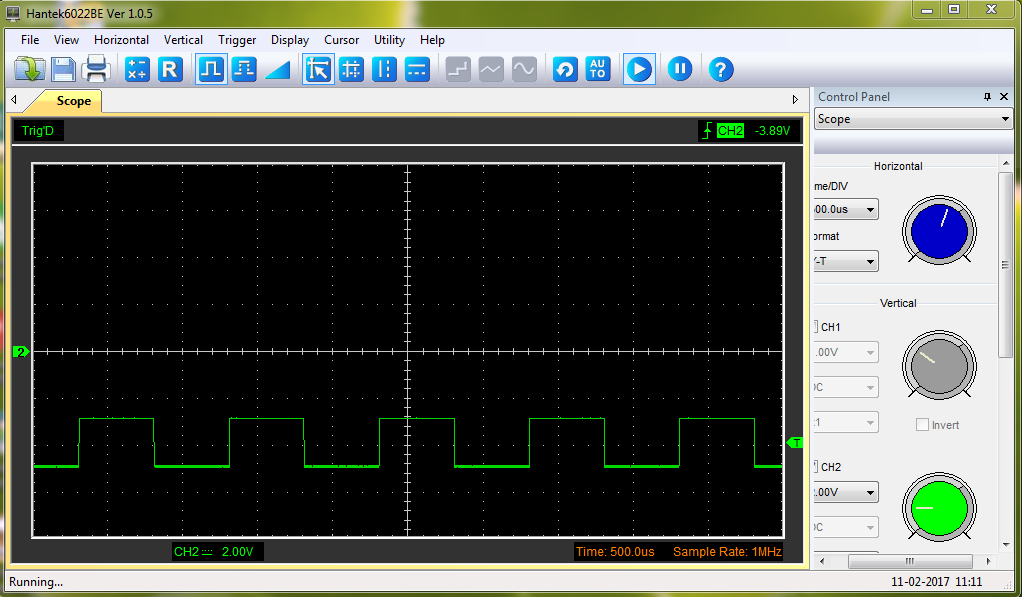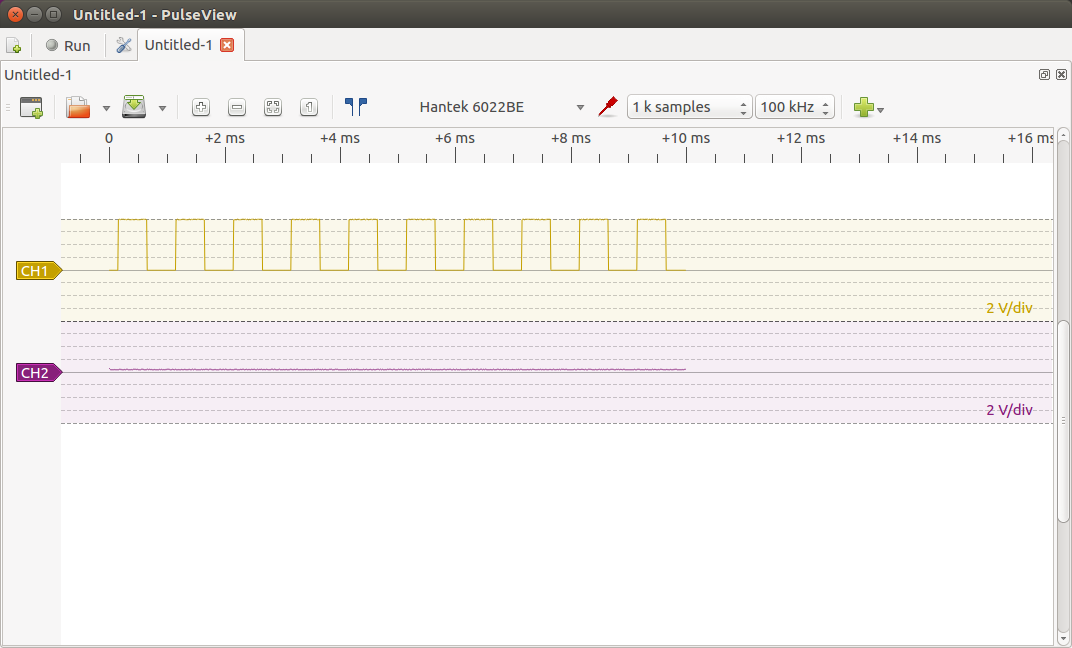The Hantek 6022BE Digital Storage Oscilloscope
For the course on embedded systems we need an oscilloscope to be able to see certain signals created by micro-controller code. These signals are have a signal level of either 5V or 3.3V and are rather slow. These means that a rather limited but cheap scope is good enough for us.The Hantek 6022BE has a sampling rate of 48 MHz or a bandwidth of some 20 MHz. To make things really cheap it uses an USB interface and the display capabilities of a PC to display scope traces and a graphical user interface (GUI) of the PC to control timebase, signal sensitivity and trigger level. Donít expect features you will get on a 10 kUS$ Textronix scope, you will quickly hit the limitations of the 6022BE, however it should meet the requirements imposed by the course exercises.

The Hantek 6022BE has 2 DC coupled input channels, a calibration signal generator emitting a square signal and it is delivered with 2 80 MHz probes and a USB cable to connect it to the PC. In addition to this you get a mini CD with Windows software implementing a GUI based control program and a software development kit which allows to implement your own code.
The scope is based on a Cypress CY7C68013A chip, which is essentially a 8051 μ Controller with built in RAM, I2C and USB interface. An external I2C EPROM is used to store USB Vendor and Product ID as well as a few calibration parameters.
When the scope is plugged into the Windows PC a driver is started downloading firmware into the Cypress RAM making it ready for operation. The code is stored in RAM and must therefore re-loaded each time the scope is powered. Once the firmware is loaded the Vendor ID is changed making the scope looks like a different device. This is how the Windows application looks like:
 Channel B is connected to the calibration signal which tells us that this is a 1 kHz square wave.
Channel B is connected to the calibration signal which tells us that this is a 1 kHz square wave.The horizontal time base can be selected between 1,2,5,10,20,50,100,200,500 ns/division up to
1,2,5 s/division. Of course 1 ns/division is pretty useless on 20 MHz scope. The vertical sensitivity can be selected from 20 mV to 5V per division. You can trigger the scope in
- auto mode
- normal mode
- or single shot
- channel A + channel B
- channel A - channel B
- channel A * channel B
- channel A / channel B
- FFT (Fast Fourier Transform) showing the frequency content of the signal
Running the Hantek 6022BE under Linux
Just like in the Windows case we must first first load the scope with its firmware. There are different ways to do this:use udev rules to load the firmware using the fxload program
make the application program load the firmware if it is not loaded yet
When is scope is plugged in without the firmware being loaded it announces itself as a Cypress Semiconductor device with Vendor ID 0x04b4.
 This changes to ROHM LSI Systems (a company that probably has nothing to do with this scope) because the Vendor ID has changed to 0x4b5.
This changes to ROHM LSI Systems (a company that probably has nothing to do with this scope) because the Vendor ID has changed to 0x4b5.

When browsing the WEB for information of the Hantek 6022BE under Linux, this is what I found:
Openhantek
Then there is a driver implementation
Then there is hantek6022api
The 8051 code is given as source code as well as disassembled original code from Hantek. It also supplies a program that allows the user to read out the RAM and EPROM contents.
On my dual boot PC I loaded the original Hantek firmware into the scope, then rebooted into Linux and used the example_linux_readfirmware.py included in hantek6022api to extract this code. After disassembly with dis51 I was able to compare the code with the one included as stock firmware in hantek602api to confirm that they are identical.
Cypress, the producer of the CY7C68013A chip provides a the cyusb library
Finally there is the sigrok
 The above screen dump shows the trace read from the Hantek6022be when the probe is connected to the calibration pulse generator.
--
The above screen dump shows the trace read from the Hantek6022be when the probe is connected to the calibration pulse generator.
-- Comments
| I | Attachment | History | Action | Size | Date | Who | Comment |
|---|---|---|---|---|---|---|---|
| |
Hantek6022be.png | r1 | manage | 1180.6 K | 2017-02-09 - 16:32 | UnknownUser | |
| |
lsusb-1.png | r1 | manage | 27.2 K | 2017-01-24 - 20:47 | UnknownUser | lsusb before loading firmware |
| |
lsusb-2.png | r1 | manage | 34.5 K | 2017-01-24 - 20:48 | UnknownUser | lsusb after loading firmware |
| |
pulseview.png | r1 | manage | 50.8 K | 2017-01-24 - 20:50 | UnknownUser | pulseview |
| |
windowsSoft.png | r1 | manage | 104.6 K | 2017-02-11 - 11:46 | UnknownUser |
Ideas, requests, problems regarding TWiki? Send feedback



